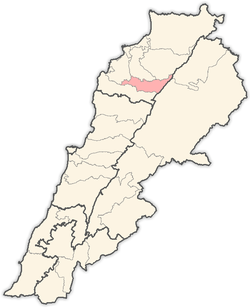Hadchit
| Hadchit حدشيت | |
|---|---|
| City | |
 Hadchit Location within Lebanon | |
| Coordinates: 34°15′07″N 35°59′07″E / 34.25194°N 35.98528°ECoordinates: 34°15′07″N 35°59′07″E / 34.25194°N 35.98528°E | |
| Country |
|
| Governorate | North Governorate |
| District | Bsharri District |
| Elevation | 1,400 m (4,600 ft) |
| Time zone | EET (UTC+2) |
| • Summer (DST) | EEST (UTC+3) |
| Dialing code | +961 |
Hadchit (also Hadshit or Hadchite, Arabic: حدشيت ) is an ancient Phoenician settlement located in the Bsharri District in the North Governorate of Lebanon. It is situated in the Valley of Qadisha, overlooking the southern branch of the valley, Wadi Qannoubine Valley. The majority of the people are adherents of the Maronite Catholic faith, and with a small Roman Catholic minority. The village is located 126 km away of Beirut with an elevation of 1400m above sea level, and accessible from two main roads Tripoli->Ehden->Hadchit or Kosba->Bcharre->Hadchit. Hadchit has an estimated population of 7000 people.
History
Hadchit's ancient political center was located in Tyre. The government was Byzantine, so the natives were required to fight in the military or find employment. The inhabitants of Hadchit were a mixture of many peoples. The majority were Canaanites, Phoenician and Aramean, who later became known as the Syriac.
Nomination
There are several stories, namely: Phoenician: (Hadash) new moon or half-moon, so Hadsheet would mean the “new one” or the “new village”. Syriac: It means one of the six temples that were built by Batlimos the 5th , King of Egypt in Mount Lebanon according to the story narrated by Sheikh Antonios Abi Khattar in his book “The Synopsis of Lebanon’s History”, (kept as a reference at the Jesuits Fathers’ library)
Religious role
There are many historical evidences indicating that our society helped in keeping the sect from collapsing against other beliefs. For example: – Patriarch Daniel Hadsheeti 1278: In his era, the Maronites extracted the Chrism from olive oil and balm grease after it was extracted from 12 different greases. He died as a martyr while fighting courageously the Mameluk invaders for 40 days at Ehden gate. – David Ben Joseline: He was ordained in 1401 by the Patriarch John El Jaji and it seemed that this Bishop was a historian. He was succeeded by his nephew, David son of John Ben Joseline who was a historian and a Bishop in the days of Patriarch Ben Joseph Ben Jacob famous by the name of son of Hassan. Among the stories narrated about the constancy of Hadsheet people in serving the Church, we mention the story of Priest Jacob from Habsha who went on to Saint Georges’ Convent located in Kanoubin valley and surnamed it by the Convent of Habash. He was then sacked by the people of Hadsheet and was banished to the prairies. Among the religious monuments, we mention: The various Churches all over the village and its valley, namely: the Church of Saint Romanos, built under the supervision of Priest Bard El Hadsheeti, the Convent of the Cross which displays many drawings and sculptures on its walls, the Convent of Saint Chamouna, Mar Sarkis and Bakhos Church. In contemporary times the Rizk and el-Koura families administer the religious life within Hadchit.
Political role
Hadsheet played an important role in leading the society although this role opposes the Maronites’ firm beliefs and the village’s traditions. In the era of Major Abdul Mon’em Bin Assaf, the Jacobeans entered the society after it won over the grace of Major Bin Assaf who quarreled with the Patriarch. In attempt to reinforce his religious and political position, he called for some Jacobeans, and among them Hajj Hassan and made Hadsheet as their lodge. Among the Jacobeans who came to the village is the Priest Hanna who distinguished himself by changing the religious motives and trying to establish a laic law for the region’s government with the support of the Major, as well as his brothers, Priest Elija who became a Bishop and Chidiak Gerges, Sheikh of Hadsheet at that time.
Economic status of Hadsheet
The main source of economy in Hadsheet society was agriculture. Therefore irrigation channels were built as well as agrarian networks. Among its important products are apple, pear, etc… Although the industry in Hadsheet is still at the rise of its progress, it is mostly active in the construction field and some craftworks as well as the production of alcoholic beverages.
